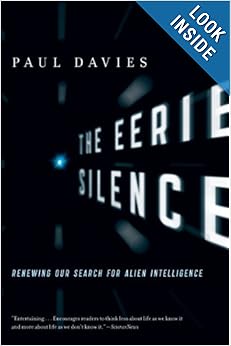 Davies, director of the Beyond Center for Fundamental Concepts in Science at Arizona State University and the author of The Eerie Silence:Renewing Our Search for Alien Intelligence, notes ,
Davies, director of the Beyond Center for Fundamental Concepts in Science at Arizona State University and the author of The Eerie Silence:Renewing Our Search for Alien Intelligence, notes ,
The underlying problem is complexity. Even the simplest bacterium is, at the molecular level, staggeringly complex. Although we have no idea of the minimal complexity of a living organism, it is likely to be very high. It could be that some sort of complexifying principle operates in nature, serving to drive a chaotic mix of chemicals on a fast track to a primitive microbe. If so, no hint of such a principle has been found in laboratory experiments to re-create the basic building blocks of life.
On the other hand, if life arose simply by the accumulation of many specific chemical accidents in one place, it is easy to imagine that only one in, say, a trillion trillion habitable planets would ever host such a dream run. Set against a number that big — and once you decide a series of unlikely accidents is behind the creation of life, you get enormous odds very easily — it is irrelevant whether the Milky Way contains 40 billion habitable planets or just a handful. Forty billion makes hardly a dent in a trillion trillion.
Okay, so we have already got as far as it happened and apparently it wasn’t an accident.
Davies suggests that we now focus our research on life forms here on Earth that do not appear related to any others: “The discovery of just a single “alien” microbe under our very noses would be enough to conclude that the universe was indeed teeming with life.”
Okay, I’ve pointed out before that the dogmatic insistence on a universal common ancestor is a handicap in origin of life research. It would at least make more sense to think in terms of an ancient environment friendly to the formation of life, perhaps several or a number of times. But it makes no sense that the discovery of Davies’ alien microbe “would be enough to conclude that the universe was indeed teeming with life.” It would at most demonstrate that a given period in Earth’s history was more favourable to the spontaneous origin of life forms than any known subsequent one (because we take it as a given that spontaneous generation does not now occur).
As for the space aliens, well, to conjure them, Davies insists on placing Darwin’s dead hand firmly back on the scale:
Although the pathway from microbes to complex thinking beings like humans may still be a very difficult one, at least we know the mechanism whereby it happens — Darwinian evolution. If microbial life is widespread in the cosmos, we can expect that, at least here and there, sentient beings will evolve. We would then be much closer to answering that age-old puzzle of existence: Are we alone in the universe?
Davies needs to talk to the people who seriously propose that bacteria can evolve to evolve, which means evolution has foresight, the opposite of what Darwin’s followers say.
Evolution with foresight might do the trick all right but then we’d have to start by taking Darwin’s dead hand off the scale and putting it back in the coffin.
See also: But surely we can’t conjure an entire advanced civilization?